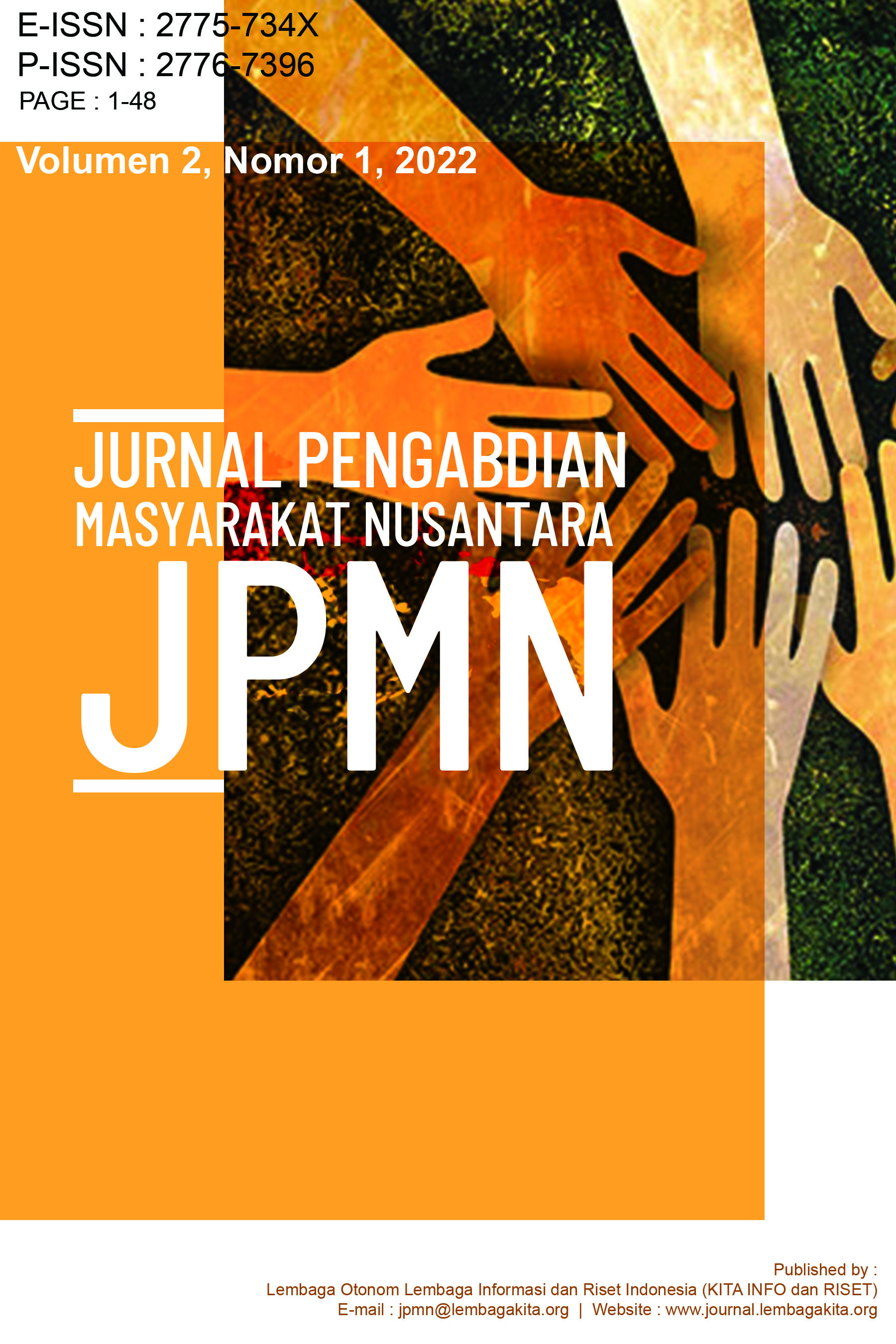Published: 2022-02-05
PENINGKATAN PENDAPATAN MASYARAKAT DESA PULO RUNGKOM MELALUI PERTANIAN INTENSIF
DOI: 10.35870/jpmn.v2i1.515
Lindawati Lindawati, Sri Wahyuni, Maisun Maisun, Muthaharah Muthaharah
- Lindawati Lindawati: STIE Bumi Persada Lhokseumawe , Indonesia
- Sri Wahyuni: STIE Bumi Persada Lhokseumawe , Indonesia
- Maisun Maisun: STIE Bumi Persada Lhokseumawe , Indonesia
- Muthaharah Muthaharah: STIE Bumi Persada Lhokseumawe , Indonesia
Article Metrics
- Views 0
- Downloads 0
- Scopus Citations
- Google Scholar
- Crossref Citations
- Semantic Scholar
- DataCite Metrics
-
If the link doesn't work, copy the DOI or article title for manual search (API Maintenance).
Abstract
Indonesia was once known agrarian country because the large numbers of its inhabitants earned as farmers. In any case, this country has possibly lose the farmers, this is because of low income form agricultural products, thereby causing change shaping in work. The cause of decline in agricultural sector is the agricultural sector is considered less prestigious and does not provide guarantess for income. Hence, effort are needed to keep agricultural production running and have the option to make an expansion in farmers income by apllying minapadi cultivation agricultural technology. The purpose for this activity is to acquaint technology agriculture to increase income the community. Activities are carried out using the village community empowerment methode and the activity implementation. The targets are farmers, traders, youth organization and representatives of PKK. The outcome acquired are the arrangement of joint business and increment the income of farmers.
Keywords
Cultivation ; Minapadi ; Income ; Technology ; Agricultural
Article Metadata
Peer Review Process
This article has undergone a double-blind peer review process to ensure quality and impartiality.
Indexing Information
Discover where this journal is indexed at our indexing page to understand its reach and credibility.
Open Science Badges
This journal supports transparency in research and encourages authors to meet criteria for Open Science Badges by sharing data, materials, or preregistered studies.
How to Cite
Article Information
This article has been peer-reviewed and published in the Jurnal Pengabdian Masyarakat Nusantara (JPMN). The content is available under the terms of the Creative Commons Attribution 4.0 International License.
-
Issue: Vol. 2 No. 1 (2022)
-
Section: Articles
-
Published: %750 %e, %2022
-
License: CC BY 4.0
-
Copyright: © 2022 Authors
-
DOI: 10.35870/jpmn.v2i1.515
AI Research Hub
This article is indexed and available through various AI-powered research tools and citation platforms. Our AI Research Hub ensures that scholarly work is discoverable, accessible, and easily integrated into the global research ecosystem. By leveraging artificial intelligence for indexing, recommendation, and citation analysis, we enhance the visibility and impact of published research.




No author biographies available.
-
-
-
-
-
-
-
-
-
-
-
-
-
Gurung, T. B., Bista, J. D., dan Dhakal, H. P. 2002. Ecological Principle of Rice-Fish Farming and Research Experiences: An Implication for Wider Adoption. In T. B. Gurung & A. Subedi (Eds.), Rice-Fish Farming: An AdoptionFor Rice Filed Productivity Enhancement. Agriculture Research Station (Fisheries), Pokhara of NARC Nepal: 11-20.
-
-
-
-
-
-
-
-
Dinas Pertanian Kota Bima. https://pertanian.bimakota.go.id/web/kontent/44/tanaman_pangan. Diakses pada 09 November 2021.
-
-

This work is licensed under a Creative Commons Attribution-NonCommercial-NoDerivatives 4.0 International License.
Authors who publish with this journal agree to the following terms:
1. Copyright Retention and Open Access License
Authors retain copyright of their work and grant the journal non-exclusive right of first publication under the Creative Commons Attribution 4.0 International License (CC BY 4.0).
This license allows unrestricted use, distribution, and reproduction in any medium, provided the original work is properly cited.
2. Rights Granted Under CC BY 4.0
Under this license, readers are free to:
- Share — copy and redistribute the material in any medium or format
- Adapt — remix, transform, and build upon the material for any purpose, including commercial use
- No additional restrictions — the licensor cannot revoke these freedoms as long as license terms are followed
3. Attribution Requirements
All uses must include:
- Proper citation of the original work
- Link to the Creative Commons license
- Indication if changes were made to the original work
- No suggestion that the licensor endorses the user or their use
4. Additional Distribution Rights
Authors may:
- Deposit the published version in institutional repositories
- Share through academic social networks
- Include in books, monographs, or other publications
- Post on personal or institutional websites
Requirement: All additional distributions must maintain the CC BY 4.0 license and proper attribution.
5. Self-Archiving and Pre-Print Sharing
Authors are encouraged to:
- Share pre-prints and post-prints online
- Deposit in subject-specific repositories (e.g., arXiv, bioRxiv)
- Engage in scholarly communication throughout the publication process
6. Open Access Commitment
This journal provides immediate open access to all content, supporting the global exchange of knowledge without financial, legal, or technical barriers.
